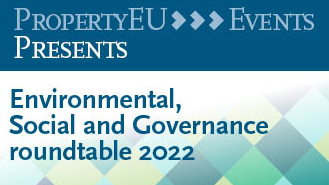The topic of environmental, social and governance (ESG) matters has been brought into sharp focus in recent times, thanks to the lessons of the pandemic, new EU regulations, and alarming emerging metrics on emissions and the impact of the built environment’s carbon footprint.
The PropertyEU ESG Roundtable 2022, an online event which took place on 3 February, assembled a panel of ESG experts to debate the hottest issues around this topic.
Speakers included Marco Abdallah, head of engineering and sustainability, Drees & Sommer UK; Katherine Beisler, head of ESG consulting, Hollis; Sandrine Fauconnet, ESG manager Europe, Cromwell Property Group; Iris Kampers, ESG advisor Netherlands, Savills; and Julie Villet, head of ESG and innovation, Mileway.
Speaking for around 90 minutes, the panel concluded that while the industry has grasped the importance of the topic, the ‘devil is in the detail’ in terms of enacting sustainable strategies. However, the mood was positive overall, as the experts welcomed how the theme has moved centre stage in recent times.
Factors driving attention to ESG
Paying attention to ESG matters isn’t merely seen as an inconvenience today – it has become embedded in industry business models as an opportunity to make a difference. Mileway’s Villet explained how this Blackstone portfolio company, launched in September 2019, now has over 1,700 assets across 10 regions covering more than 15 million m².
Specialising in last-mile logistics, Mileway has assembled a large and diverse portfolio of well-located properties – often in infill locations due to their proximity to urban centres. This means Mileway is focused on transforming these existing buildings to ensure they better meet changing market needs but also – importantly – de-risking through an increased emphasis on ESG. ‘ESG is in our value proposition,’ Villet underlined.
‘Our whole idea is to acquire existing buildings and make them more efficient, future-proof and resilient – and thus more valuable. We see increased focus from investors and tenants on the issue – it’s not going away.’
Kampers of Savills agreed that the theme has become ubiquitous. ‘We are all seeing the changes in regulation, from Paris-proof to EU Taxonomy, and a lot of clients are asking for our help. Occupier and end-user demand for ESG-compliant assets is strong, while access to financing is changing based on these metrics. At the same time, there is a growing enthusiasm in the industry for the topic. Over the past year at Savills I have been working on setting up a new ESG strategy for the Netherlands; I’ve seen how my colleagues, especially the youngest ones, really seem driven by an intrinsic motivation to tackle these issues.’
Added Cromwell’s Fauconnet: ‘It’s not just about regulations, it’s also the fact that investors are starting to have their own requirements, driven by their own end-users. To maintain assets under management (AUM) and expand further we need to respond to that. We anticipate price dislocation: we expect that assets which comply with ESG criteria will increase in value, while those that don’t will see a negative performance impact. So, it’s important for us to be able to embed ESG throughout our investment cycle within our portfolio.’
Noted Drees & Sommer’s Abdallah: ‘As consultants, we have a view on the real estate market as well as a responsibility in our own company, which is climate positive to act on ESG issues. If we look at the market, there’s a real difference between the past and what we see today. Initiated by the UN Sustainable Development Goals, and the Paris Climate Agreement, the industry realised that sustainability is not just an “option” anymore, it is a “duty”, driven by new regulations.’
Concluded Beisler: ‘As a pan-European consultant, at Hollis we see the differences between different countries. The change in attitude over the last 10 years has been huge – it’s no longer a niche topic. I think that comes from three main things: the first is legislation, in Europe and beyond, which is the main thing driving 80% of our clients. The second is that clients are interested in future-proofing portfolios and are trying to get ahead of current guidance. Lastly, it’s their tenants, or LPs, that want to know how ESG-compliant they are. Many owners are being asked these important questions for the first time.’
ESG growing pains
Despite a broad understanding of the importance of the topic across the industry, its application and execution is not without problems. The panellists shared their views on the chief pain points of making an ESG strategy work.
Said Fauconnet: ‘Being engaged in the topic isn’t the issue anymore. The problem now is data and the management of the sheer volume of data. The regulations around the world are different; you have to report in different ways, for example in post-Brexit UK or in EU territories. Managing the data to respond to all of that is a headache, and even getting to it can be a problem – we haven’t always had that access to the relevant data from tenants.
'We are trying to have a “single golden source of truth” for reporting, and we probably aren’t the only ones trying to solve that problem. This also means selecting the right data providers and trying to pick a partner with longevity, as it’s a part of the industry which is in intense evolution.’
Added Villet: ‘I agree that how you get the data in the first place is tricky, particularly with recently acquired buildings. While we are at an early stage, we have a clear path forward and are working with strong partners, such as Schneider Electric, to automate and digitise how we track and capture data.
'A lot of regulations are coming in, and it feels like those regulations are good triggers to push the capital markets into action. However, currently it tends to be easier to attract sustainable capital to both develop new buildings and acquire EPC A rated-buildings, than to renovate existing stock. But 85% of our current building stock will still be there in 2050, so that’s the chief issue, really – and we’re renovating that stock at a rate of just 1% per year. Great asset management is required.’
Said Fauconnet: ‘We believe that the data you collect will inform the targets you set yourself – both mandatory and voluntary targets. People also want progressive targets. NREP has set a highly aggressive target of getting its buildings carbon-neutral by 2028, way ahead of the 2050 goal set by Paris.’
Added Kampers: ‘What I also see with our clients is that when you set targets, you often run into conflict. One action to improve a data set – for example, swapping out heating pipes – might negatively impact another goal, such as circularity. So, then you’re faced with two options with different performance outcomes. We are all trying to save the world in our own way, but there are different paths and different ideas about doing that.
'Biodiversity, for example, is a tough one. Older buildings often house different species which count as biodiversity, but in a very grey environment. Is it then better to demolish and replace with a vertical forest? I am not so sure.’
Noted Beisler: ‘We do a lot of work on existing buildings and gathering data, and a lot of energy modelling. One of the most basic things we need is a building floor plan – and sometimes even that is hard to get hold of! If we inherit a project where someone made a data room five years ago, we’ll have to do it again for the next client.
'There’s also a lot of terminology that even property owners aren’t clear on, so we spend a lot of time extrapolating the jargon and making it all more transparent. Everyone is working on targets right now.’
Said Abdallah: ‘We often meet with clients who are struggling in the jungle of regulations. They need clarity on what is really relevant for them – that starts with creating an overview and clarity. The second challenge is to translate those targets into real estate terms – what it means for your building portfolio.
‘Third, we have done numerous Taxonomy analyses, but find that if you ask different people to do assessments of the same building, they may have different results. One reason might be that the EU Taxonomy was primarily “written” by politicians with a lot of negotiated compromises, so it’s not as clear as we’d like.
‘And of course, the bigger the portfolio, the more necessary it is to find a lean and coherent approach to crunch all that data. We have invested in our own “SuPer-Tool”, which is currently in development, with which we want to ease those pain points. It shows which assets are “bad”, which are “good” regarding sustainability, so you can immediately see the issues and derive optimisation routes for different properties. I think 2022 and 2023 are going to be big, important years for progress in this area.’
Certification – still relevant?
With so many certifications around and more subsets emerging, our panel discussed how useful they truly are – and how much they risk being just a greenwashing or marketing exercise.
Said Beisler: ‘They can be great and give important guidelines. We do them all, as each client often has different needs. But a lot of people feel restricted by certification; they also want to do things they don’t get points for. We encourage them to go for it anyway, as doing the right thing for the environment should be the greater goal.’
Suggested Kampers: ‘They can guide awareness on ESG matters – and certification may substitute part of the admin for the EU Taxonomy in the future.’
Added Abdallah: ‘Labels can be useful, but sometimes they are just about paperwork. If you can use certification to impact design in a proactive way, it starts to make sense. A label doesn’t necessarily prove that a building is outstanding, it only suggests that it’s not totally unsustainable.’
Countered Fauconnet: ‘Certificates are not the solution, and can actually drive quite poor behaviour. I think the mentality around them needs to change, and greater, clearer, differentiation between standards would help. We are establishing a jointly-managed class 9 SFDR impact fund, for example, and finding the right certification to demonstrate operational net zero has not been an easy task.’
Said Villet: ‘I do believe there is a strong need and demand for 3rd party recognition, a tool which can help investors make decisions. We need data-backed certificates, but the disconnect is real between quality and utility, especially on the energy topic. EPCs and BREEAM for example aren’t really in step. For us we focus more on doing what is needed to improve the underlying value of the assets. Customers want operationally efficient properties, so let’s focus on lower bills and greater energy generation.’
The ‘S’ factor
If compiling data and measuring energy consumption is hard enough, the panellists agreed that the elusive ‘S’ in ESG remains one of the trickiest parts of the equation.
Said Beisler: ‘The “S” emerged as a key issue during the pandemic, and it’s now something we are frequently asked about. We do a lot of due diligence work looking at “S” factors, including the health and wellbeing of workers on site, access and transport, and more. We have a client with a grocery store portfolio and they came up with their own ideas, including managing food waste and educational programmes. Social impact payback periods can be difficult to measure, although there are ways to assess successful placemaking and give a community its own identity.’
Added Fauconnet: ‘A focus on aspects such as diversity and equality is also important. In the UK, various universities have social mobility programmes which allow companies like Cromwell to sponsor students who could not otherwise attend. In return for that sponsorship, students can take part in an internship at the firm. For a new development in Scotland, we are using a contractor who has an apprenticeship programme to bring the long-term unemployed back into the workforce. Companies are starting to embrace these kinds of changes and there is a lot of training now around unconscious bias.’
Said Abdallah: ‘The entire real estate sector has tunnel vision on zero carbon. Social factors are becoming more and more important and are amongst the most challenging. But it is becoming a requirement for occupiers – data on sick leave is a concrete way of showing if you are treating your workers right, and reveals the financial impact of social aspects. Health and wellbeing matters for business.’
Added Beisler: ‘I’d second that. When WELL and Fitwel were emerging as certifications, it wasn’t clear to me if they were part of ESG. Now health and wellbeing have moved centre stage. Companies spend more on personnel than on any other factor, so it makes sense to focus on increasing happiness and productivity – there’s so much to be gained.’
Said Villet: ‘In our case, as a relatively young company that has grown fast, we are still finalising our approach but it’s something that is embedded in what we do and is an important part of our corporate culture. We have acted quickly and intuitively when needed – for example we were able to provide rent relief during Covid and coordinate donations during the floods in Germany and the lowlands last summer; we are also working to facilitate social mobility, and our UK teams are pioneering a partnership with the Brokerage, a social mobile charity, to help drive inclusion in the workplace.
'Lastly, our diverse tenant base means there is a lot more we can do to support growth and SMEs in our portfolio, we’re not just serving the big 3PLs and Amazon. Generating prosperity also adds to social impact.’



































